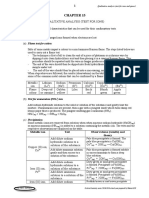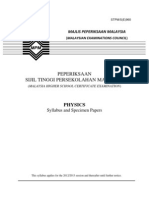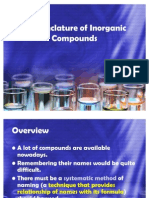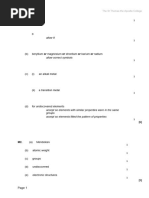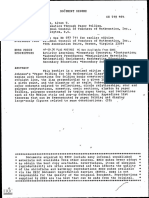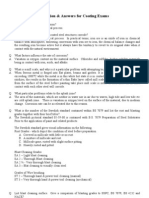STPM Chemistry Experiment 14
STPM Chemistry Experiment 14
Uploaded by
Ling Gen Sheng ShaunCopyright:
Available Formats
STPM Chemistry Experiment 14
STPM Chemistry Experiment 14
Uploaded by
Ling Gen Sheng ShaunCopyright
Available Formats
Share this document
Did you find this document useful?
Is this content inappropriate?
Copyright:
Available Formats
STPM Chemistry Experiment 14
STPM Chemistry Experiment 14
Uploaded by
Ling Gen Sheng ShaunCopyright:
Available Formats
STPM Chemistry Experiment 14
Topic: Qualitative analysis
Purpose: To determine the cations and anions of inorganic substances
Procedure:
1. Solids KA1 and KA2 are simple salts. Carry out the following experiments with solid
KA1 to identify its cation and anion.
2. You are then required to carry out a few experiments to identify the cation and anion
present in solid KA2. In all the experiments, the reagent should be added gradually until
no further change is observed. Deduce what you can about KA1 and KA2. Observations
should include details of colour changes, precipitates, and tests on gases evolved.
Tests on KA1
Add dilute hydrochloric acid to a small amount of solid KA1, then warm gently.
Observation: Solutions smells like vinegar.
Deduction: Solution contains CH3COO- ions.
Dissolve solid KA1 in distilled water and filter. Use separate portions of the filtrate for
the following tests.
Add aqueous sodium hydroxide, then in excess.
Observation: A white precipitate is formed.
Deduction: Solution contains either Pb2+ ions, Zn2+ ions or Al3+ ions.
Add aqueous ammonia, then in excess followed by aqueous ammonium chloride.
Observation: Solution turns cloudy and a white precipitate is formed.
Deduction: Solution contains either Pb2+ ions or Al3+ ions.
Add aqueous iron (III) chloride, then warm.
Observation: Solution turns brown and a white precipitate is formed.
Deduction: Solution contains CH3COO- ions.
Add aqueous silver nitrate, followed by dilute nitric acid.
Observation: A white precipitate is formed.
Deduction: Solution contains CH3COO- ions.
Add aqueous disodium hydrogen phosphate.
Observation: Solution turns white and a white precipitate is formed.
Deduction: Solution contains Pb2+ ions.
Add aqueous potassium chromate (VI) followed by dilute hydrochloric acid.
Observation: A yellow precipitate is formed.
Deduction: Solution contains Pb2+ ions.
Identity of KA1: KA1 contains Pb2+ ions and CH3COO- ions.
Tests on KA2
Add concentrated hydrochloric acid and test for gas(es) evolved by using lime water.
Observation: Lime water turns chalky.
Deduction: The reaction releases carbon dioxide gas. Solution contains CO32- ions.
Dissolve KA2 in dilute nitric acid. Use separate portions of the solution for the following
tests.
Add dilute sodium hydroxide.
Observation: A blue precipitate is formed.
Deduction: Solution contains Cu2+ ions.
Add potassium hexacyanoferrate (II).
Observation: Solution turns dark brown.
Deduction: Solution contains Cu2+ ions.
Identity of KA2: KA2 contains Cu2+ ions and CO32- ions.
You might also like
- Notes Salts (Chemistry)Document32 pagesNotes Salts (Chemistry)Darishana100% (4)
- PT326-Round2 Expt3 Batch19Document6 pagesPT326-Round2 Expt3 Batch19Radhey MeenaNo ratings yet
- Report Scince 2 (SEM 2)Document10 pagesReport Scince 2 (SEM 2)Hanani KharudinNo ratings yet
- Tests For Ions and GasesDocument5 pagesTests For Ions and GasesRobert EdwardsNo ratings yet
- SALT ANALYSISDocument11 pagesSALT ANALYSISOnly For StudiesNo ratings yet
- notes_20240920111858Document4 pagesnotes_20240920111858lakshmiponganesanNo ratings yet
- Inorganic Material Chemistry: Dr. Farhat NosheenDocument7 pagesInorganic Material Chemistry: Dr. Farhat NosheenBS CHEMISTRYNo ratings yet
- Chemistry Lab ReportDocument6 pagesChemistry Lab ReportNajihah IsmailNo ratings yet
- QUALITATIVE ANALYSIS ONLINE LESSON WITH MR NKWOCHADocument34 pagesQUALITATIVE ANALYSIS ONLINE LESSON WITH MR NKWOCHAeerandomstuff1211No ratings yet
- Class-IX Subject-Chemistry Half-Yearly Syllabus Handout-4 Chapter-18 Chemical TestsDocument6 pagesClass-IX Subject-Chemistry Half-Yearly Syllabus Handout-4 Chapter-18 Chemical TestsZunaira AliNo ratings yet
- DOC-20241216-WA0005.Document17 pagesDOC-20241216-WA0005.atif.shaikh9330No ratings yet
- Salt and SolutionDocument33 pagesSalt and SolutionFarhan Altaf100% (1)
- XI salt 9-Calcium carbonateDocument3 pagesXI salt 9-Calcium carbonateSankar MurugesanNo ratings yet
- Test For Anions (Chemistry)Document22 pagesTest For Anions (Chemistry)abby jacksonNo ratings yet
- Screenshot 2024-08-20 at 19.42.26Document2 pagesScreenshot 2024-08-20 at 19.42.26sp9j4sqd47No ratings yet
- Chemical Tests Chapter 18Document3 pagesChemical Tests Chapter 18mbot6659No ratings yet
- Qualitative Analysis of Cations and AnionsDocument24 pagesQualitative Analysis of Cations and AnionsNidhi Chaudhary33% (3)
- Org. Chem 2Document8 pagesOrg. Chem 2JamesShiqNo ratings yet
- Group 1 CationsDocument5 pagesGroup 1 CationsJoann Justiniane H67% (3)
- HSSC2 PRACTICALS 24-25 newDocument15 pagesHSSC2 PRACTICALS 24-25 newnew.newmybNo ratings yet
- Chemistry Unit 3B Notes 6CH07Document14 pagesChemistry Unit 3B Notes 6CH07RG_penNo ratings yet
- Ion Test PDFDocument11 pagesIon Test PDFAnderson XiaoNo ratings yet
- Ammonium Carbonate and Lead AcetateDocument8 pagesAmmonium Carbonate and Lead AcetatedallenainaNo ratings yet
- C12 Chemical Analysis and InvestigationDocument10 pagesC12 Chemical Analysis and InvestigationSarah PendNo ratings yet
- Keningau Teacher Training College PRACTICAL 2: Qualitative AnalysisDocument5 pagesKeningau Teacher Training College PRACTICAL 2: Qualitative AnalysisAndre SilusNo ratings yet
- Experiment 19Document3 pagesExperiment 19Beenu SinghNo ratings yet
- Chem 169 First Labs_UpdatedDocument23 pagesChem 169 First Labs_UpdatedemmanuelemlucksNo ratings yet
- Procedure Act 2Document8 pagesProcedure Act 2Rhealyn Legaspi100% (2)
- Activity 2.5 Explanation: How Do Metal Carbonates and Metal Hydrogencarbonates React With Acids?Document1 pageActivity 2.5 Explanation: How Do Metal Carbonates and Metal Hydrogencarbonates React With Acids?sciencee2009100% (1)
- Solution Formation Electrolytes Acids and Bases Strong and Weak Acids and Bases Concentration Percent Concentration Molarity Molar-Solutions-SolidsDocument71 pagesSolution Formation Electrolytes Acids and Bases Strong and Weak Acids and Bases Concentration Percent Concentration Molarity Molar-Solutions-SolidsDexter EnthusiastsNo ratings yet
- 3.SALT ANALYSIS Cobalt NitrateDocument4 pages3.SALT ANALYSIS Cobalt Nitratemohnish75% (4)
- Acids, Bases and Salts Notes Part 2Document8 pagesAcids, Bases and Salts Notes Part 2Dhyan ShahNo ratings yet
- Salt Analysis I - Lead Acetate - (Ch3coo) 2pb-1Document28 pagesSalt Analysis I - Lead Acetate - (Ch3coo) 2pb-1YashikNo ratings yet
- POCDocument31 pagesPOCpranavbharti011No ratings yet
- Qualitatile Inorganic AnalysisDocument9 pagesQualitatile Inorganic AnalysisRamanNo ratings yet
- Test (In details)Document3 pagesTest (In details)Keyur GalaNo ratings yet
- Qualitative AnalysisDocument7 pagesQualitative AnalysisDavid MorganNo ratings yet
- 6.SALT ANALYSIS Lead AcetateDocument3 pages6.SALT ANALYSIS Lead Acetatemohnish67% (9)
- 6Document16 pages6ayushkr1021No ratings yet
- Determination of Cation and Anion of The SubstancesDocument12 pagesDetermination of Cation and Anion of The SubstancesSunny02No ratings yet
- Selina-Sol-Concise-Chem-Class-10-Ch-8 JGHHJKDocument6 pagesSelina-Sol-Concise-Chem-Class-10-Ch-8 JGHHJKPROGRAMMING HUBNo ratings yet
- Chem.Exp. No.7 SaltDocument3 pagesChem.Exp. No.7 Saltzxcgu8901234No ratings yet
- 1617 Level M Chemistry Brush-Up Make-Up Material PDFDocument5 pages1617 Level M Chemistry Brush-Up Make-Up Material PDFAndrewNo ratings yet
- CH 2 Acids Bases and Salt - Docx-1Document27 pagesCH 2 Acids Bases and Salt - Docx-1deeptibansal1984No ratings yet
- CH 2 Acids Bases and SaltDocument27 pagesCH 2 Acids Bases and Saltlegendpr31No ratings yet
- Purification and Characterisation of Organic CompoundsDocument20 pagesPurification and Characterisation of Organic CompoundspsshivaNo ratings yet
- Reactions, ObservationsDocument12 pagesReactions, ObservationsSaraNo ratings yet
- 2-Test For Ions (Qualitative Analysis)Document3 pages2-Test For Ions (Qualitative Analysis)Nkemzi Elias NzetengenleNo ratings yet
- Unit 3 - PracticalsDocument50 pagesUnit 3 - Practicalsaminathns451No ratings yet
- Poc One Shot Bounce BackDocument123 pagesPoc One Shot Bounce BackCOOLTEX YTNo ratings yet
- Oxalic AcidDocument15 pagesOxalic AcidNomi DhillonNo ratings yet
- Exp5 (Chloride Ion)Document2 pagesExp5 (Chloride Ion)Vayuna GuptaNo ratings yet
- Single Organic Test PDFDocument15 pagesSingle Organic Test PDFgreatNo ratings yet
- Gp-V_CaSO4Document2 pagesGp-V_CaSO4moinakd2No ratings yet
- Advanced Pharmaceutical analysisFrom EverandAdvanced Pharmaceutical analysisRating: 4.5 out of 5 stars4.5/5 (2)
- The Chemistry of Fertilisers and Manure - Including Information on the Chemical Constituents and Types of Fertilisers and ManuresFrom EverandThe Chemistry of Fertilisers and Manure - Including Information on the Chemical Constituents and Types of Fertilisers and ManuresRating: 5 out of 5 stars5/5 (1)
- Ligand Platforms in Homogenous Catalytic Reactions with Metals: Practice and Applications for Green Organic TransformationsFrom EverandLigand Platforms in Homogenous Catalytic Reactions with Metals: Practice and Applications for Green Organic TransformationsNo ratings yet
- Practice Makes Perfect in Chemistry: Acids, Bases, and Salts with AnswersFrom EverandPractice Makes Perfect in Chemistry: Acids, Bases, and Salts with AnswersNo ratings yet
- Practice Makes Perfect in Chemistry: Oxidation-ReductionFrom EverandPractice Makes Perfect in Chemistry: Oxidation-ReductionRating: 5 out of 5 stars5/5 (1)
- 960 SP Physics 2012Document135 pages960 SP Physics 2012Mohd SharulniZamNo ratings yet
- Halus 2009Document1 pageHalus 2009RabiahNo ratings yet
- Chemistry Syllabus Form 6Document33 pagesChemistry Syllabus Form 6SIVANESVARAN83% (6)
- STPM Maths T Sem 1 Past Year by ChapterDocument27 pagesSTPM Maths T Sem 1 Past Year by ChapterKenneth Chan100% (5)
- 4 1 Biological Molecules 5k2N9MQVNPVzhmbQDocument25 pages4 1 Biological Molecules 5k2N9MQVNPVzhmbQlinh058905100% (1)
- 2018 Sec 1 Express Math SA2 (Set A) - 12sDocument379 pages2018 Sec 1 Express Math SA2 (Set A) - 12sdanNo ratings yet
- Pressor ManualDocument25 pagesPressor ManualThane MasureikNo ratings yet
- Differential Pulse Code ModulationDocument10 pagesDifferential Pulse Code Modulationthevin arokiarajNo ratings yet
- QB SW TestingDocument3 pagesQB SW TestingAkshada PadekarNo ratings yet
- Reactivity LO's and IGCSE NotesDocument10 pagesReactivity LO's and IGCSE Notesm.sarmadrehanNo ratings yet
- Flow-X4 Process Controller: Benefits Powertools (Option)Document4 pagesFlow-X4 Process Controller: Benefits Powertools (Option)Tanmoy DeyNo ratings yet
- 18101a0011 Devops Exp-5Document4 pages18101a0011 Devops Exp-5shravani kadamNo ratings yet
- A New Approach For The Effectiveness of Coaxiality Tolerance VerificationDocument11 pagesA New Approach For The Effectiveness of Coaxiality Tolerance VerificationJuan Posada GNo ratings yet
- Math3 - q1 - Mod13 - Subtracting 3-To-4 Digit Numbers From 3-To-4 Digit Numbers - 08092020Document20 pagesMath3 - q1 - Mod13 - Subtracting 3-To-4 Digit Numbers From 3-To-4 Digit Numbers - 08092020YoshidaNo ratings yet
- 9 Nomenclature of Inorganic CompoundsDocument42 pages9 Nomenclature of Inorganic CompoundsGlen MangaliNo ratings yet
- Roll Type - Versus - Free Fall - Electrostatic20160127 20216 1qotrprDocument5 pagesRoll Type - Versus - Free Fall - Electrostatic20160127 20216 1qotrprlaurNo ratings yet
- Name Sundas Fatima Id F2017065292 Section W3Document3 pagesName Sundas Fatima Id F2017065292 Section W3SUNDAS FATIMANo ratings yet
- Sheet 4Document4 pagesSheet 4wejebil523No ratings yet
- 05 Catalog SIP E6 Overcurrent ProtectionDocument204 pages05 Catalog SIP E6 Overcurrent ProtectionGiang Cao ThoNo ratings yet
- 8.1 Physics of The AtmosphereDocument16 pages8.1 Physics of The AtmosphereAnonymous xwNTkPaOrNo ratings yet
- NW3P1 ZH-CN enDocument12 pagesNW3P1 ZH-CN enCosmo MovieNo ratings yet
- FMF-01-10-911-303 - 150 GPM - 60 HZ Electric Motor DriveDocument1 pageFMF-01-10-911-303 - 150 GPM - 60 HZ Electric Motor DriveMarkNo ratings yet
- 002 Testing of Hypothesis - One SampleDocument14 pages002 Testing of Hypothesis - One SampleDhananjay Chavan100% (1)
- A Beautiful Mind (2001) 1080p BluRay 10bit HEVC 6CH 3.3GB - MkvCageDocument2 pagesA Beautiful Mind (2001) 1080p BluRay 10bit HEVC 6CH 3.3GB - MkvCagedroopyboreNo ratings yet
- Task Sheet - UC 1: //192.168.1.56 //serverDocument1 pageTask Sheet - UC 1: //192.168.1.56 //serverHerwin CapiñanesNo ratings yet
- BVC Institute of Technology and Science,: AmalapuramDocument24 pagesBVC Institute of Technology and Science,: Amalapurambhanu455No ratings yet
- c2 Periodic Table MarkschemeDocument18 pagesc2 Periodic Table MarkschemeDorthix the IINo ratings yet
- (Doc Truoc) Topology Optimization and The Evolution Trends of Two-Speed Transmission of EVs (Cau Truc, Xu Huong Phat Trien)Document17 pages(Doc Truoc) Topology Optimization and The Evolution Trends of Two-Speed Transmission of EVs (Cau Truc, Xu Huong Phat Trien)Tung Nguyen TheNo ratings yet
- Mathematics Through Paper FoldingDocument66 pagesMathematics Through Paper Foldingr2d2sdNo ratings yet
- Sustainable Planning of Multipurpose Hydropower Reservoirs With EnvironmentalDocument18 pagesSustainable Planning of Multipurpose Hydropower Reservoirs With EnvironmentalAlex BaciuNo ratings yet
- Functions Generation - Discrete Mathematics Questions and Answers - SanfoundryDocument8 pagesFunctions Generation - Discrete Mathematics Questions and Answers - SanfoundrymbsureshNo ratings yet
- Question BGASDocument17 pagesQuestion BGASAbdulRahman Mohamed Hanifa86% (7)
- Units and Measurement ModuleDocument11 pagesUnits and Measurement Modulemujeebc 1972No ratings yet















































